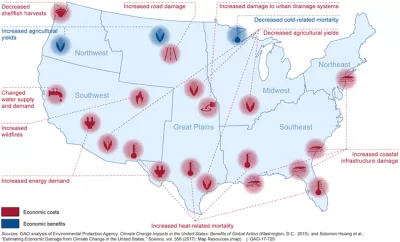The deadline for the first discretionary program to accept applications since the Infrastructure Investment and Jobs Act was signed into law was April 14, marking the day as one of the most consequential in America’s response to climate change.

April 22, a.k.a. Earth Day, is one of the most widely celebrated environmental events across the globe. The day is dedicated to increasing awareness about the uniqueness of our planet, its issues, and its problems. More than one billion people now participate in Earth Day activities each year, making it the largest civic observance in the world.
This year’s Earth Day arrived on the heels of arguably a far more consequential day for Planet Earth. April 14 marked the application deadline for the massive $1.5 billion U.S. Department of Transportation (USDOT) Rebuilding American Infrastructure with Sustainability and Equity (RAISE) discretionary grant program. The program helps communities across the country with capital investments needed to carry out projects with substantial local or regional impact.
The significance of this deadline should not be underestimated. RAISE is the first U.S. DOT discretionary funding program to accept applications since the landmark Infrastructure Investment and Jobs Act (IIJA) was signed into law by President Biden last November, according to U.S. DOT. It’s also one of the largest discretionary programs available to the administration to spend on priorities. So, for climate activists, this will be the first opportunity since IIJA was passed to see if Biden is going to put his money where his mouth is—figuratively speaking—and prioritize spending that will help the United States meet the Paris Agreement.
Will these funds be used to pay for new highway on-ramps or complete streets projects with multimodal travel options? Will this administration build new roads, or invest in cutting-edge technology deployments aimed at reducing congestion? The answer to these questions and others will signal just how serious Biden is about tackling climate change.
These decisions are made all the more important because the United States remains the second-largest emitter of greenhouse gas emissions globally. And transportation-sourced GHG emissions top all other sectors, including agriculture and electricity generation, according to the federal Environmental Protection Agency (EPA). This means every transportation dollar is a climate dollar.
But IIJA funds need to be spent carefully, warns a Georgetown Climate Center study. The bipartisan infrastructure package could lead to an increase in greenhouse gas emissions depending on how its transportation funding programs are implemented, according to a post about their findings. For example, the legislation’s surface transportation provisions could be used to expand highways or build new major roadways, potentially leading to higher emissions in the long term.
If there is one thing Secretary of Transportation Pete Buttigieg has going for him, it’s deep pockets. Buttigieg will control $126 billion in new IIJA spending over the next five years, more than one-fifth of the new spending authorized by the law. And the 2022 $1.5 billion RAISE program represents a 50 percent increase in available funds compared to last year when applicants requested 10 dollars for every $1 available.
There is more good news. The popular RAISE program is designed to fund projects with substantial technology components, focusing on multimodal projects that will reduce greenhouse gas emissions, and create workforce development opportunities. If these funds are administered properly, climate activists should see a step in the right direction.
So while Earth Day may get the headlines, in the long run, April 14, 2022, could end up having a bigger impact on Planet Earth’s fate. Let’s hope the U.S. DOT officials who are reviewing these RAISE proposals understand what is at stake, heed the warnings from the Georgetown Climate Center, and administer this program the way it was intended.

Alabama: Trump Terminates Settlements for Black Communities Harmed By Raw Sewage
Trump deemed the landmark civil rights agreement “illegal DEI and environmental justice policy.”

Planetizen Federal Action Tracker
A weekly monitor of how Trump’s orders and actions are impacting planners and planning in America.

The 120 Year Old Tiny Home Villages That Sheltered San Francisco’s Earthquake Refugees
More than a century ago, San Francisco mobilized to house thousands of residents displaced by the 1906 earthquake. Could their strategy offer a model for the present?

BLM To Rescind Public Lands Rule
The change will downgrade conservation, once again putting federal land at risk for mining and other extractive uses.

Indy Neighborhood Group Builds Temporary Multi-Use Path
Community members, aided in part by funding from the city, repurposed a vehicle lane to create a protected bike and pedestrian path for the summer season.

Congestion Pricing Drops Holland Tunnel Delays by 65 Percent
New York City’s contentious tolling program has yielded improved traffic and roughly $100 million in revenue for the MTA.
Urban Design for Planners 1: Software Tools
This six-course series explores essential urban design concepts using open source software and equips planners with the tools they need to participate fully in the urban design process.
Planning for Universal Design
Learn the tools for implementing Universal Design in planning regulations.
Clanton & Associates, Inc.
Jessamine County Fiscal Court
Institute for Housing and Urban Development Studies (IHS)
City of Grandview
Harvard GSD Executive Education
Toledo-Lucas County Plan Commissions
Salt Lake City
NYU Wagner Graduate School of Public Service


























